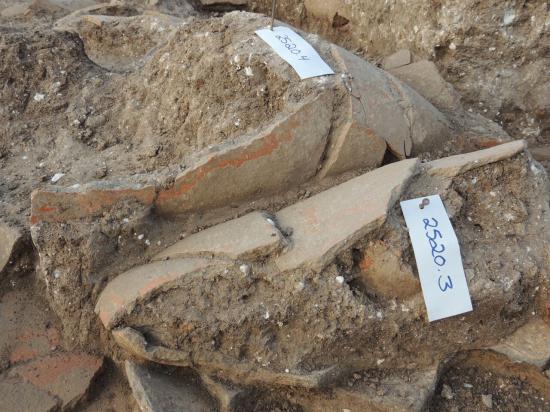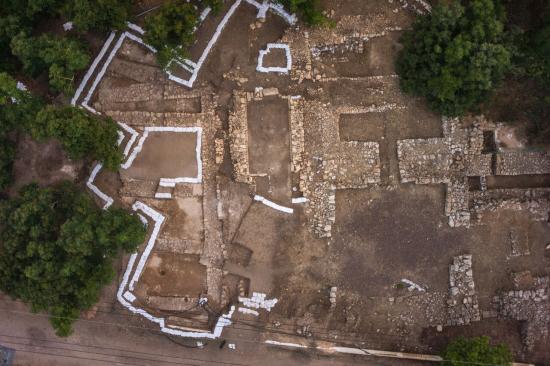New findings at sprawling 4,000-year old Canaanite palace include 120 huge jars - and seeds, from which we may be able to rediscover the ancient grape.
Julia Fridman
Source - http://www.haaretz.com/life/archaeology/1.668265
 Large pithoi found at Tel Kabri, in what appears to be one of four (maybe five) storage rooms. Photo by Eric Cline
Large pithoi found at Tel Kabri, in what appears to be one of four (maybe five) storage rooms. Photo by Eric Cline
What may be the biggest concentration of storage jars in ancient Canaan has been uncovered at the Tel Kabri palatial complex in northern Israel, dating about 4,000 years ago.
A room full of clay storage jars, dubbed the "wine cellar," had been found there in the last season. Now the latest excavation season at the site, located in an avocado orchard in the north just five kilometers from the Mediterranean coast, has uncovered three more rooms containing no less than about 70 storage jars.
Altogether, the excavators say, they uncovered at least 120 restorable jars still in situ in four storage rooms in the southern storage area of the palace (including pieces found in the last seasons). They may have also found a fifth storage room in a different building complex located to the northwest. "The rooms have not all been fully excavated," points out Assaf Yasur-Landau of the University of Haifa: the number will probably double when that's done, he adds.
All the jars are undergoing organic residue analysis in order to determine their contents, the excavators told Haaretz. Residue analysis of the jars found in the first storage room during the previous excavation season showed they had contained an aromatic red wine.
Original Canaanite grapes
We don't know who lived at the Tel Kabri palace, which is a vast 6,000 square meters in area, let alone what the place was called at the time – not a shred of written evidence has been found there. We do know that the palace was inhabited continuously for over 250 years, from about 1850 BCE to the 1600s BCE, and that it featured multiple banquet rooms and halls.
The palace at Tel Kabri is unique in the Levant for this period, and appears to have more affinities to the Aegean than to anything in the more immediate area. It is most similar to the massive palace of Knossos in Crete although a similar palace was found at Mari as well.
The palace at Kabri was a sprawling place with rooms constantly being added to it over the years. The ruler would have lived inside and his subjects would have lived outside, coming to the palace for special occasions like feasts, or to pay taxes or tribute.
Absent findings of writing at the site, its history is being "glued together" through excavations by Yasur-Landau and Eric H. Cline of George Washington University.
 Tel Kabri, the 4,000-year old remains of a Canaanite palace that is more like ones found at Knossos and Mari than the Levant. (Photo: Griffin Aerial Imaging/Skyview Photography)
Tel Kabri, the 4,000-year old remains of a Canaanite palace that is more like ones found at Knossos and Mari than the Levant. (Photo: Griffin Aerial Imaging/Skyview Photography)
“The goal of this season was to further understand the Canaanite palatial economy, by expanding the excavation beyond the area where the jars were found last season. We were hoping to find additional store rooms, thinking about the palace of Mari and the palaces in Crete from the same period - but to find ones that are actually filled with jars was unexpected," says Yassur-Landau. "This kind of a find is a once in a lifetime opportunity to learn about Canaanite economy and rulership."
It now looks like the ‘wine cellar’ was actually the northernmost room in a storage complex with at least four rooms in a row.
It can also now be said that the storage rooms had plastered floors and contained a range of types of jars. For example, room 2520 had pithoi (handleless storage jars) of two types, one around one meter tall and smaller, more slender pithoi, up to 80 centimeters in height.
In the center of room 2520, the excavators also found a juglet, two shallow bowls, and a chalice, crushed under the weight of a fallen pithos.
Palatial economy
Another unusual find was the middle of room 2533: an installation made of a sunken half of a pithos, still intact, still holding grape seed remnants, as well as pieces of charcoal. The installation appears to have been used to collect liquids spilled in the room.
This particular room had the biggest amount of crushed jars and pithoi, apparently more than 50 jars of various types.
The grape seeds are an incredible find. Not only can they help date the site: their analysis can help us rediscover the original Canaanite grape.
The grapes grown in Israel today are very tasty, but they're strains brought by Baron Edmond James de Rothschild in the late 19th century. The famed wine industry of the Levant, which had existed for millennia, had been wiped out during Islamic rule of the region, starting in the 7th century CE.
Last season the excavators tested the substance found in the large jars from the first storage room and found, as said, evidence of spiced wine.
“This season yielded 80 organic residue analysis (ORA) samples taken from approximately 70 unique vessels," says Yassur-Landau. "Last season's samples were taken from large storage vessels that proved to have contained spiced wine but the 80 samples from this season were more varied, including smaller storage jars with handles possibly used for transport and a larger assortment of fine ware.”
The samples will further the understanding of Canaanite eating habits and augment our understanding of the economy of the time, the archaeologists hope.